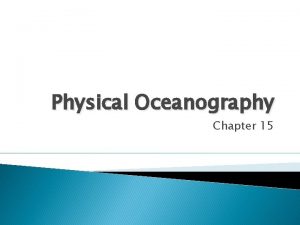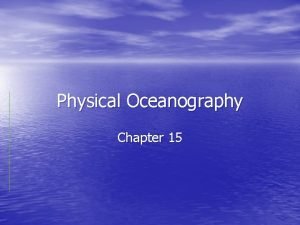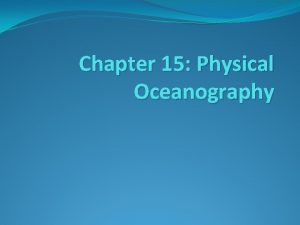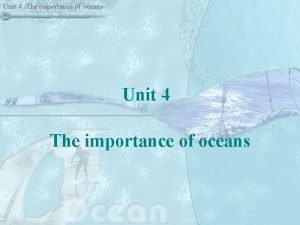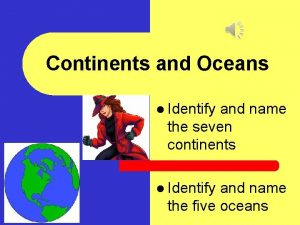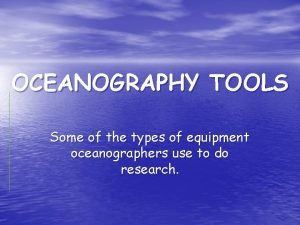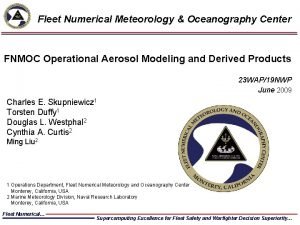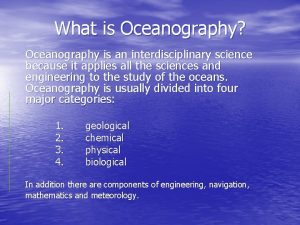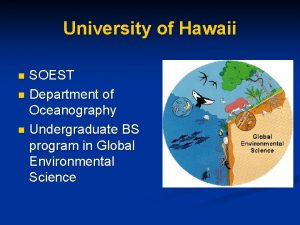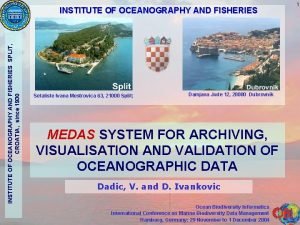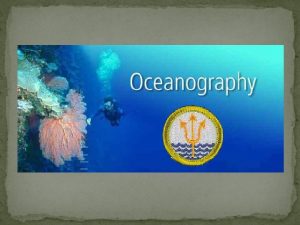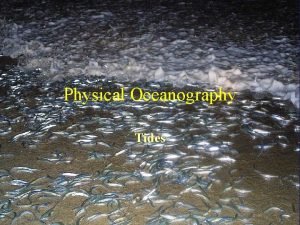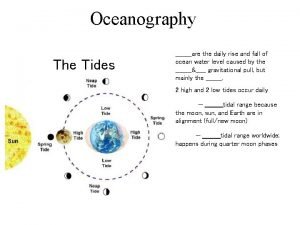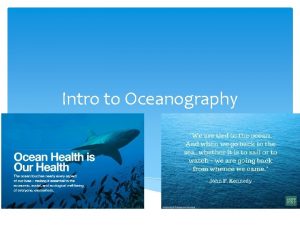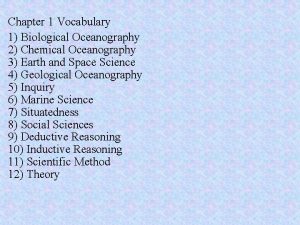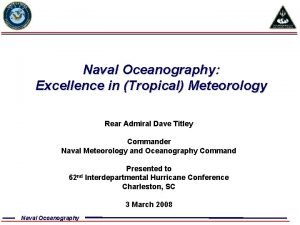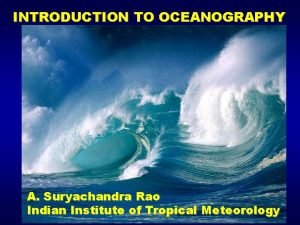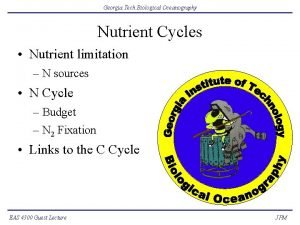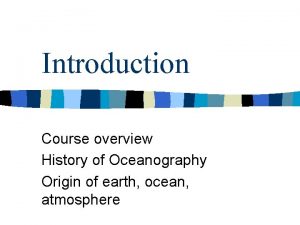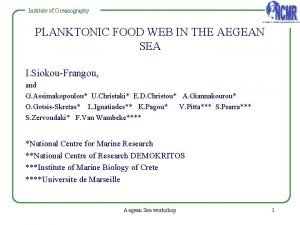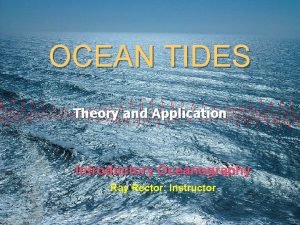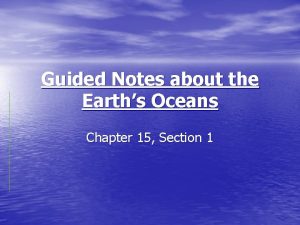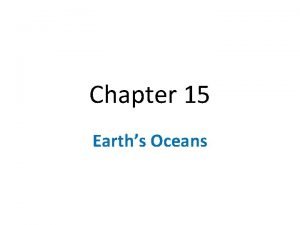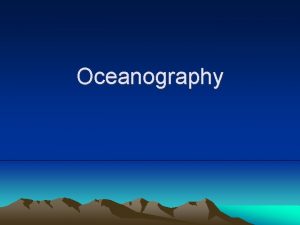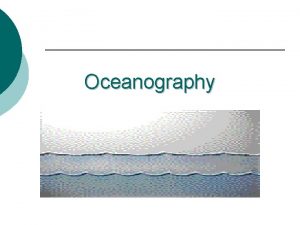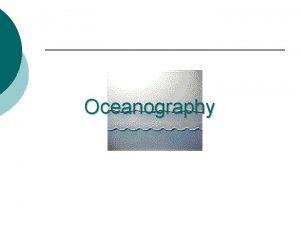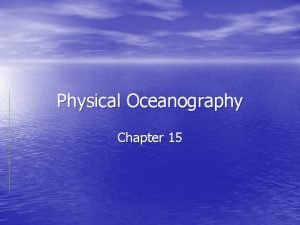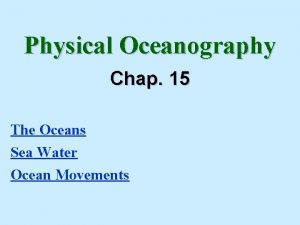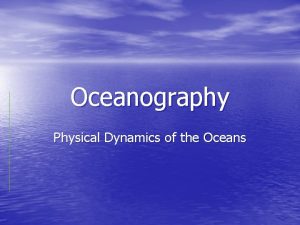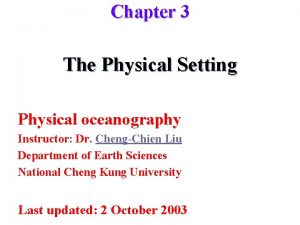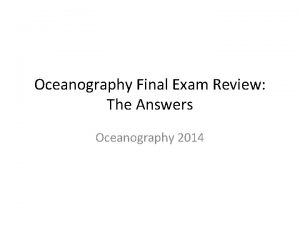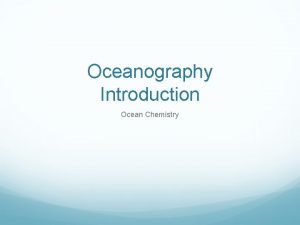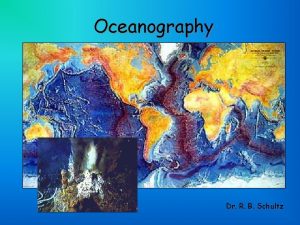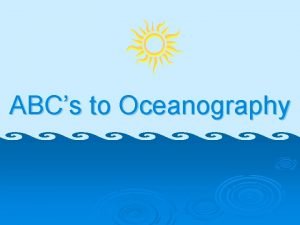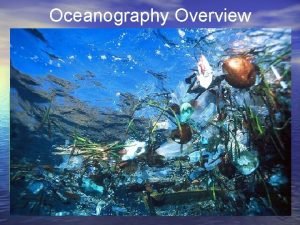Chapter 15 Physical Oceanography Importance of Oceans Oceans































- Slides: 31

Chapter 15: Physical Oceanography

Importance of Oceans �Oceans are important sources of food, energy, and minerals. �Energy sources such as oil and natural gas are found beneath the ocean floor.

Importance of Oceans �Approximately one-third of the world’s table salt is extracted from seawater through the process of evaporation. �Oceans also allow for the efficient transportation of goods. For example, millions of tons of oil, coal, and grains are shipped over the oceans each year.

�Oceanography – study of Earth’s oceans

�SONa. R – sound navigation and ranging �Uses return time of an echo and the known velocity of sound in water to determine water depth �Side-scan Sonar – sound waves hit floor at an angle so features are mapped �Has mapped large portions of the seafloor


Origins of Water �Scientists hypothesize that Earth’s water could have originated from two sources �Comets and meteorites colliding with the planet � Impacts release water, possibly enough to fill the ocean basins over geologic time �Volcanoes – emit significant quantities of gas, mostly water vapor and carbon dioxide � Earth cooled and water vapor condensed into oceans

Distribution of Earth’s Water � 97% of water in oceans, 3% of water is fresh �The percentage of ice on Earth has varied over geologic time from near zero to as much as 10% of the hydrosphere �Global sea level has risen and fallen by hundreds of meters in response to melting and freezing ice �Tectonic forces that lift or lower portions of the seafloor

The Blue Planet � 71% of Earth’s surface is covered by oceans �Average depth of an ocean is 3800 meters �All the oceans are really one vast, interconnected body of water �Divided into specific oceans and seas because of historic and geographic considerations

Major Oceans �Pacific Ocean �Largest – contains roughly half of Earth’s seawater �Atlantic � 2 nd largest – extends from Antarctica to the arctic circle �Arctic �Atlantic Ocean north of the arctic circle �Indian �Located mainly in the southern hemisphere

Minor Oceans �Antarctic �Storm-lashed region surrounding Antarctica �South of 50 degrees south latitude �Sometimes referred to as the Southern Ocean

Seas �Seas are smaller than oceans and are partly or mostly landlocked � 3 major seas are �Mediterranean �Caribbean �Bering

15. 2 Seawater

Seawater �Seawater is a solution of about 96. 5% water and 3. 5% dissolved salts. �Most abundant salt in seawater is sodium chloride (Na. Cl) �Other salts present are chlorides and sulfates of magnesium, potassium, and calcium �Salinity is the measure of the amount of dissolved salts in seawater


Variations in Salinity �Average salinity of the oceans is 35 ppt (parts per thousand) �Salinities higher in subtropics due to higher rates of evaporation �In equatorial regions salinities are lower due to abundant precipitation �Polar regions low due to melting sea ice �Lowest salinities occur where large rivers empty into the ocean


Sources of Sea Salt �Ancient seas salinity not much different from today �Volcanic gases contain chlorine and sulfur dioxide �Gases dissolve in water and form the chlorine and sulfate ions of seawater �Weathering of crustal rocks generates most of the other abundant ions in seawater �Sodium, calcium, potassium, iron, magnesium

Removal of Sea Salts �Salinity in ocean never really increases �Removal involves several processes �Some precipitate from seawater near arid, coastal regions �Small salty spray droplets from breaking waves are picked up by winds and deposited inland �Marine organisms also remove ions from seawater to build their shells, bones, and teeth


Physical Properties of Seawater �Physical properties of seawater are quite different than freshwater �Salt ions are heavier than water molecules and increase the density �The freezing point of seawater -2 degrees C �Determining factors for temperature are �Depth �Latitude �Salinity

Temperature �Average Sea-Surface Temperature (SST) = 26 C �Ocean water temperatures decrease significantly with depth �Zones �Surface � 0 -100 meters � Little to no temperature change

�Thermocline (intermediate) � 100 -1000 m �Rapid decrease in temperature �Bottom �Below 1000 m �Temperature levels out and becomes stable because of pressure

Absorption of Light �Light intensity decreases with depth �Water absorbs light �Penetrates only the upper 100 m of seawater �Photosynthesis will only occur in this first 100 m �Some blue light reaches below that, but is not used for photosynthesis

Light Zones �Sunlit Zone – Euphotic Zone � 100 -200 ft �>90% of marine animals live here �Twilight Zone – Disphotic Zone �About 900 ft �Midnight Zone – Aphotic Zone �Below 900 ft

Other Zones �Littoral Zone �Between tide lines �Neritic �Low tide line to the edge of the continental shelf �Pelagic �Open ocean �Benthic �Bottom of open ocean

15. 3 Ocean Movements

�Oceans are never completely motionless �Most obvious movement is the constant motion of the waves �Rhythmic movement that carries energy through space or matter �Water moves up and down in a circular pattern and returns to its original position

Waves �Typical wave characteristics �Crest – highest point of a wave �Trough – lowest point of a wave �Wave height – distance between crest & trough �Wave length – distance from crest to crest

Wave Height �Depends on 3 things �Wind speed �Wind duration(how long) �Fetch (how much distance wind blows across)

Breaking Waves �As ocean waves reach the shallow water near shorelines, they lose energy because of friction with the ocean bottom �Waves slow down �Incoming waves become higher, steeper, and unstable, and their crests collapse forward �Breakers – waves where the crest collapse
 Chapter 15 physical oceanography
Chapter 15 physical oceanography Chapter 15 physical oceanography
Chapter 15 physical oceanography Chapter 15 physical oceanography
Chapter 15 physical oceanography Importance of oceans
Importance of oceans Europe asia africa
Europe asia africa Tools used in oceanography
Tools used in oceanography Fnmoc meteorology products
Fnmoc meteorology products Oceanography branches
Oceanography branches Is oceanography and interdisciplinary science?
Is oceanography and interdisciplinary science? University of hawaii soest
University of hawaii soest Split institute of oceanography and fisheries
Split institute of oceanography and fisheries Occacaris
Occacaris Essentials of oceanography
Essentials of oceanography Oceanography
Oceanography Oceanography
Oceanography Chemistry oceanography
Chemistry oceanography Polynesians oceanography
Polynesians oceanography Scripps institution of oceanography
Scripps institution of oceanography Chemistry oceanography
Chemistry oceanography Chemical oceanography definition
Chemical oceanography definition Chemistry oceanography
Chemistry oceanography Oceanography
Oceanography Oceanography
Oceanography Institute of oceanography and fisheries
Institute of oceanography and fisheries Oceanography
Oceanography Oceanography
Oceanography History of oceanography
History of oceanography Oceanography
Oceanography Essentials of oceanography
Essentials of oceanography Chapter 15 earth's oceans study guide answer key
Chapter 15 earth's oceans study guide answer key Chapter 15 earth's oceans
Chapter 15 earth's oceans Morraine glacier
Morraine glacier
